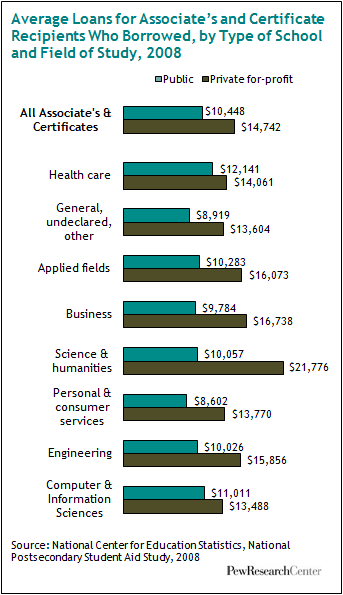 The average amount borrowed by recipients of associate’s degrees and undergraduate certificates doubled from 1996 to 2008. Although associate’s degrees and undergraduate certificates typically receive less attention than bachelor’s degrees, they account for about half of the undergraduate credentials awarded by colleges and universities. Overall, an associate’s degree or certificate recipient in 2008 borrowed $6,649 on average, up from $3,318 in 1996.11
The average amount borrowed by recipients of associate’s degrees and undergraduate certificates doubled from 1996 to 2008. Although associate’s degrees and undergraduate certificates typically receive less attention than bachelor’s degrees, they account for about half of the undergraduate credentials awarded by colleges and universities. Overall, an associate’s degree or certificate recipient in 2008 borrowed $6,649 on average, up from $3,318 in 1996.11

 The share of associate’s degree and certificate recipients from private for-profit schools who borrowed increased, from 78% in 1996 to 95% in 2008. The likelihood that an associate’s or certificate graduate of a public institution would borrow increased slightly, from 35% in 1996 to 38% in 2008. Private not-for-profit schools account for a relatively small and shrinking portion of associate’s degrees and certificates, and the sample size is too small for meaningful analysis before 2008.
The share of associate’s degree and certificate recipients from private for-profit schools who borrowed increased, from 78% in 1996 to 95% in 2008. The likelihood that an associate’s or certificate graduate of a public institution would borrow increased slightly, from 35% in 1996 to 38% in 2008. Private not-for-profit schools account for a relatively small and shrinking portion of associate’s degrees and certificates, and the sample size is too small for meaningful analysis before 2008.
 Among graduates who borrowed, the total loan debt increased substantially at both public and private for-profit schools. Associate’s degree and certificate borrowers at public schools raised their average loan amount from $6,130 in 1996 to $10,448 in 2008, an increase of 70%. At for-profit schools, borrowers’ average debt increased from $9,131 to $14,742, or by 61%.
Among graduates who borrowed, the total loan debt increased substantially at both public and private for-profit schools. Associate’s degree and certificate borrowers at public schools raised their average loan amount from $6,130 in 1996 to $10,448 in 2008, an increase of 70%. At for-profit schools, borrowers’ average debt increased from $9,131 to $14,742, or by 61%.
For-profit schools granted nearly a third of all associate’s degrees and certificates in 2009, compared with slightly more than one-quarter of awards in 2003.
High-debt borrowing also increased from 1996 to 2008. Overall, one-in-ten associate’s degree or certificate graduates borrowed more than $20,000 in 2008, compared with 6% of graduates in 1996. At private for-profit institutions, 22% of 2008 awardees graduated with more than $20,000 in loans (up from 15% in 1996).
Graduates of associate’s degree and certificate programs at for-profit schools are demographically somewhat different from graduates of similar programs at other schools.12 For-profit school graduates are more likely to be women (74%) than are graduates of public (61%) or private not-for-profit (67%) schools. Nearly seven-in-ten graduates of for-profit schools are lower income (67%), compared with slightly more than 40% at public and private not-for-profit schools. Almost half (48%) of for-profit school graduates have children or other dependents, compared with 34% at public schools and 40% at private not-for-profit schools.
Below the bachelor’s level, for-profit schools offer a different mix of degrees than public institutions. In 2008, for instance, 77% of credentials in personal and consumer services and 38% of health care credentials were granted by for-profit institutions, compared with 9% of awards in science and humanities and 18% of awards in business.13 The borrowing differences between public and private for-profit schools persist for all fields of study in which for-profit schools produce a significant number of graduates.


